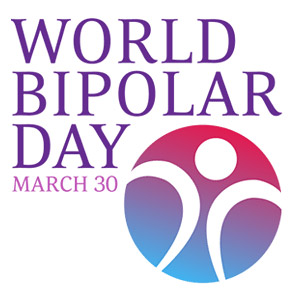World Bipolar Day March 30th

“The vision of World Bipolar Day is to bring world awareness to bipolar disorders and to eliminate social stigma. World Bipolar Day (WBD) – an initiative of the Asian Network of Bipolar Disorder (ANBD), the International Bipolar Foundation (IBPF), and the International Society for Bipolar Disorders (ISBD) – will be celebrated each year on March 30th, the birthday of Vincent Van Gogh, who was posthumously diagnosed as probably having bipolar disorder.”
Bipolar affective disorder, or manic-depressive illness, is a mood disorder characterized by periods of profound depression that alternate with periods of excessive elation and irritable mood known as mania. Individuals will suffer from extreme mood swings that interfere with personal relationships, occupational function, and daily activities. Just like any mental health disorder, bipolar disorder is surrounded by stigma and false ideas creating significant barriers to treatment. The name “bipolar” gives many false connotations, and many believe that calling this disorder “manic-depressive” illness is more accurate. Although bipolar is not curable, signs and symptoms are treatable, and the individual can live a fulfilling life. The following are common myths associated with bipolar disorder:
Myth: People with bipolar disorder have multiple personalities
Fact: Bipolar disorder is characterized by periods of fluctuating depression and mania that alternate weeks or months at a time. Depression can be categorized by feelings of loneliness, loss of interesting, difficulty concentrating and sleeping and sadness whereas mania is characterized by excessive elation, impulsivity, and irritability.
Myth: People with bipolar disorder change their moods every day.
Fact: Bipolar disorder is generally misconstrued as a disorder of rapidly ricocheting moods that go from deep misery to extraordinary elevated self-belief however this common mood disorder is much more complicated than the assumed emotional labile rollercoaster that our society believes. Individuals with bipolar disorder must have manic episodes for at least one week and depressive episodes lasting for at least two weeks. Additionally, individuals with bipolar disorder usually tend to demonstrate one mood type or the other; whether it is depression or mania. Rapidly changing moods daily is not characteristic of bipolar disorder.
Myth: There is no treatment for bipolar disorder
Fact: Pharmacological treatment for both mania and depression is available; however management can be extremely complicated as it depends explicitly on whether the individual is exhibiting manic phases or depressive phases and the severity of these phases. Pharmacological therapy is indicated for manic episodes, but the specific types of medication depend on the severity of the mania and the presence of psychosis. Mood stabilizing agents and antipsychotic agents are the first-line pharmacological treatment for manic episodes. Antidepressant agents are generally not used in combination with mood stabilizers and antipsychotics as this dangerous combination can worsen an individual’s symptoms. Antidepressants are usually prescribed only when the individual is experiencing the depressed phase with no signs of mania.
Myth: Bipolar disorder is a choice
Fact: Bipolar disorder is a mental health disorder that carries a substantial genetic component. Bipolar disorder is known to have a significant genetic component involved in the etiology. First-degree relatives (parents, children, and siblings) of people with bipolar disorder type I (BPPI) are seven times more likely to develop this disorder compared to the general population. Additionally, a child of a parent with bipolar disorder is at a 50% increase in having a major psychiatric disorder diagnosed in life.
Myth: Bipolar disorder is related to schizophrenia
Truth: Bipolar disorder is a mood disorder that is characterized by depression and mania whereas schizophrenia is a psychotic disorder that is characterized by delusions and hallucinations. There are multiple types of bipolar disorder. Bipolar disorder type I (BPI) is characterized by alternative severe depression and mania which leads to hospitalization or significant impairment in functioning. In comparison, bipolar disorder type II (BPII) is characterized by episodes of severe depression that are punctuated by hypomanic episodes. Hypomania is a less severe form of mania that does not result in psychosis or cause impairments in social or occupational functioning.
